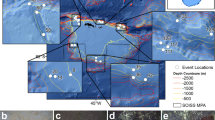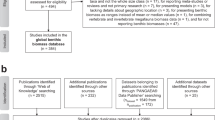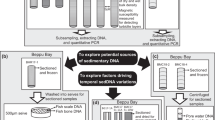Abstract
Benthic mixing or bioturbation affects sediments in various ways, including: (1) the production of trace fossils, (2) mechanical and/or chemical alteration of the sediment, and (3) filtering or smearing stratigraphical signals1. Because mixing alters both the slopes and amplitudes of any recorded events, some knowledge of the process is essential for the correct interpretation of the signals. In view of recent trends towards high-resolution stratigraphy2,3 and signal unmixing4–6, the frequency characteristics of the benthic mixing filter must be understood to determine which types of signals can be detected after mixing. Analyses of ash and tektite profiles in deep-sea cores from various geographical regions indicate that even signals from cores having sedimentation rates as high as 7 cm kyr−1 will show severe attenuation of frequencies higher than 0.35 cycles kyr−1 (periods shorter than 2.9 kyr) resulting in loss of ability to resolve closely-spaced events. Most signals will experience much more serious high-frequency attenuation, however. The severity of high frequency loss is directly related to sedimentation rate (R = 0.97 for the cores examined), suggesting that this is the most important variable to take into account when considering a core for palaeoceanographic or palaeoclimatic study.
This is a preview of subscription content, access via your institution
Access options
Subscribe to this journal
Receive 51 print issues and online access
$199.00 per year
only $3.90 per issue
Buy this article
- Purchase on Springer Link
- Instant access to full article PDF
Prices may be subject to local taxes which are calculated during checkout
Similar content being viewed by others
References
Hanor, J. S. & Marshall, N. F. in Trace Fossils (ed. Perkins, B. F.) 127–135 (SEPM, Tulsa, 1971).
Berger, W. H., Killingley, J. S. & Vincent, E. Oceanol. Acta 1, 203–216 (1978).
Kennett, J. P. & Shackleton, N. J. Science 188, 147–150 (1975).
Berger, W. H., Johnson, R. F. & Killingley, J. S. Nature 269, 661–663 (1977).
Berger, W. H. Deep-Sea Res. 25, 473–480 (1978).
Jones, G. A. & Ruddiman, W. F. Quat. Res. 17, 148–172 (1982).
Goldberg, E. D. & Koide, M. Geochim. cosmochim. Acta 26, 417–450 (1962).
Berger, W. H. & Heath, G. R. J. mar. Res. 26, 134–143 (1968).
Guinasso, N. L. & Schink, D. R. J. geophys. Res. 80, 3032–3042 (1975).
Somayajulu, B. L. K., Sharma, P. & Berger, W. H. Mar. Geol. 54, 169–180 (1984).
Graupe, D. Identification of Systems (Van Nostrand Reinhold, New York, 1972).
Peled, A. & Liu, B. Digital Signal Processing (Wiley, New York. 1976).
Glass, B. P. Earth planet. Sci. Lett. 6, 409–415 (1969).
Glass, B. P., Baker, R. N., Storzer, D. & Wagner, G. A. Earth planet. Sci. Lett. 19, 184–192 (1973).
Ruddiman, W. F. & Glover, L. K. Bull. geol. Soc. Am. 83, 2817–2836 (1972).
Ruddiman, W. F. et al. Sedim. Geol. 25, 257–276 (1980).
Ruddiman, W. F. & McIntyre, A. Palaeogeogr. Palaeoclimatol. Palaeoecol. 35, 145–214 (1981).
Officer, C. B. & Lynch, D. R. Mar. Geol. 52, 59–74 (1983).
Otnes, R. K. & Enochson, L. Digital Time Series Analysis (Wiley-Interscience, New York, 1972).
Schiffelbein, P. & Hills, S. Palaeogeogr. Palaeoclimatol. Palaeoecol. (in press).
Goreau, T. J. Nature 287, 620–622 (1980).
Berger, W. H. & Killingley, J. S. Mar. Geol. 45, 93–125 (1982).
DeMaster, D. J. & Cochran, J. K. Earth planet. Sci. Lett. 61, 257–271 (1982).
Emiliani, C. J. Geol. 538–578 (1955).
Author information
Authors and Affiliations
Rights and permissions
About this article
Cite this article
Schiffelbein, P. Effect of benthic mixing on the information content of deep-sea stratigraphical signals. Nature 311, 651–653 (1984). https://doi.org/10.1038/311651a0
Received:
Accepted:
Issue Date:
DOI: https://doi.org/10.1038/311651a0
This article is cited by
-
Time Resolution of the Phanerozoic Rock Records: Challenges of High-Resolution Palaeobiological and Geochemical Proxy-Based Interpretations
Journal of the Geological Society of India (2019)
-
Catastrophic flood outbursts in mid-continent left imprints in the Gulf of Mexico
Geo-Marine Letters (2005)
-
Reconstruction of the last deglaciation: deconvolved records of ?18O profiles, micropaleontological variations and accelerator mass spectrometric14C dating
Climate Dynamics (1987)
Comments
By submitting a comment you agree to abide by our Terms and Community Guidelines. If you find something abusive or that does not comply with our terms or guidelines please flag it as inappropriate.



